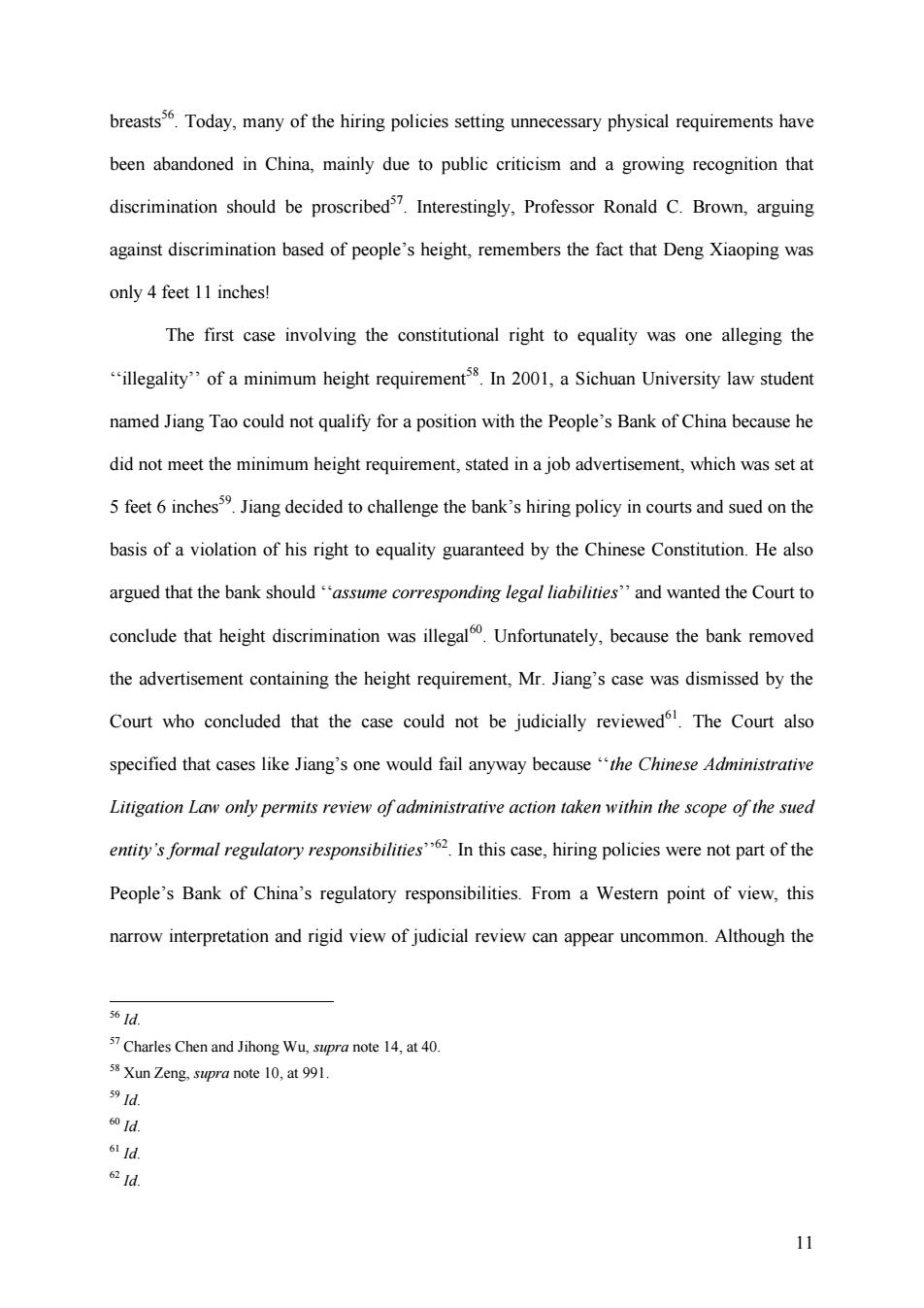正在加载图片...

breastss6 Today,many of the hiring policies setting unnecessary physical requirements have been abandoned in China,mainly due to public criticism and a growing recognition that discrimination should be proscribed37.Interestingly,Professor Ronald C.Brown,arguing against discrimination based of people's height,remembers the fact that Deng Xiaoping was only 4 feet 11 inches! The first case involving the constitutional right to equality was one alleging the "illegalityof a minimum height requirements In 2001,a Sichuan University law student named Jiang Tao could not qualify for a position with the People's Bank of China because he did not meet the minimum height requirement,stated in a job advertisement,which was set at 5 feet 6 inchess Jiang decided to challenge the bank's hiring policy in courts and sued on the basis of a violation of his right to equality guaranteed by the Chinese Constitution.He also argued that the bank shouldassume corresponding legal liabilities'and wanted the Court to conclude that height discrimination was illegal Unfortunately,because the bank removed the advertisement containing the height requirement,Mr.Jiang's case was dismissed by the Court who concluded that the case could not be judicially revieweds.The Court also specified that cases like Jiang's one would fail anyway because "the Chinese Administrative Litigation Law only permits review of administrative action taken within the scope of the sued entity's formal regulatory responsibilities In this case,hiring policies were not part of the People's Bank of China's regulatory responsibilities.From a Western point of view,this narrow interpretation and rigid view of judicial review can appear uncommon.Although the 61d. 57 Charles Chen and Jihong Wu,supra note 14,at 40. ss Xun Zeng,supra note 10,at 991. 91d. 601d. 611d. 621d. 1111 breasts56 . Today, many of the hiring policies setting unnecessary physical requirements have been abandoned in China, mainly due to public criticism and a growing recognition that discrimination should be proscribed57. Interestingly, Professor Ronald C. Brown, arguing against discrimination based of people’s height, remembers the fact that Deng Xiaoping was only 4 feet 11 inches! The first case involving the constitutional right to equality was one alleging the ‘‘illegality’’ of a minimum height requirement58. In 2001, a Sichuan University law student named Jiang Tao could not qualify for a position with the People’s Bank of China because he did not meet the minimum height requirement, stated in a job advertisement, which was set at 5 feet 6 inches59. Jiang decided to challenge the bank’s hiring policy in courts and sued on the basis of a violation of his right to equality guaranteed by the Chinese Constitution. He also argued that the bank should ‘‘assume corresponding legal liabilities’’ and wanted the Court to conclude that height discrimination was illegal60. Unfortunately, because the bank removed the advertisement containing the height requirement, Mr. Jiang’s case was dismissed by the Court who concluded that the case could not be judicially reviewed61 . The Court also specified that cases like Jiang’s one would fail anyway because ‘‘the Chinese Administrative Litigation Law only permits review of administrative action taken within the scope of the sued entity’s formal regulatory responsibilities’’62. In this case, hiring policies were not part of the People’s Bank of China’s regulatory responsibilities. From a Western point of view, this narrow interpretation and rigid view of judicial review can appear uncommon. Although the 56 Id. 57 Charles Chen and Jihong Wu, supra note 14, at 40. 58 Xun Zeng, supra note 10, at 991. 59 Id. 60 Id. 61 Id. 62 Id